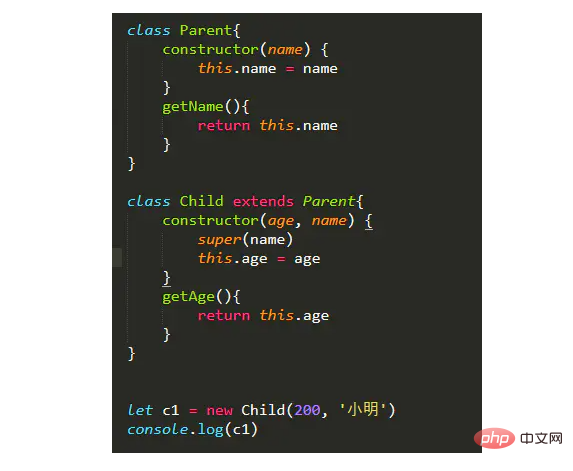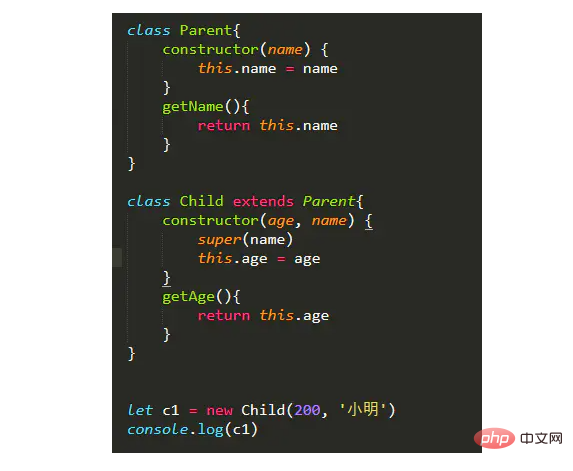JavaScript-Prototyp und Vererbung sind ein Muss für Interviews
In der Kolumne „Javascript“ werden Prototypen und Vererbung vorgestellt, die in Interviews erlernt werden müssen objektorientiert
1 Möglichkeit zum Erstellen von Objekten

2 Tipps zum Erinnern an die Prototypenkette3Instanz der Simulationsimplementierung
- 4Neue Keyword-Simulationsimplementierung
- 5Vererbungsimplementierung (Schritt-für-Schritt-Implementierung)
- 0 Wie man objektorientiert versteht
- Eigentlich weiß ich nicht, wie ich diese Frage beantworten soll. Ich weiß nur, dass der Interviewer eine Reihe von Vererbungsfragen stellen würde. Das Folgende ist ein Zitat von Lehrer Zhou. „Objektorientiert ist eine Programmieridee, die der Prozessorientierung entspricht. Allgemeine Sprachen sind objektorientiert. JS selbst ist ebenfalls objektorientiert aufgebaut. Beispielsweise verfügt js selbst über viele integrierte Klassen , wie Promise. Sie können ein neues Promise verwenden, um die asynchrone Programmierung zu verwalten. Und vue erstellt auch Instanzen von vue
-
3.Object.create
var o1 = {name: 'o1'} var o2 = new Object({name: 'o2'})Nach dem Login kopierenvar M = function(name){ this.name = name } var o3 = new M('o3')Nach dem Login kopieren2 Tipps zum Merken der Prototypenkette - Das Gedächtnis ist immer regelmäßig. Wenn Sie in der High School trigonometrische Funktionen lernen, müssen Sie sich viele Formeln merken Man kann leicht verwirrt werden, wenn man sich alle Formeln gewaltsam einprägt. Wenn Sie sich jedoch die Kernpunkte merken, ist für die restlichen Formeln nur eine kleine Herleitung erforderlich. Das Gleiche gilt für die Prototypenkette. Wenn Sie sich zu Beginn ein paar Punkte merken, werden Sie später nicht verwirrt sein. Schlüsselkonzepte in der Prototypenkette: Konstruktor
- , Instanz, Konstruktor
__Proto__
,Prototyp
, erinnern Sie sich zunächst an ihre Beziehung Instanzen (Objekte) sindProto
, Instanzen ( Objekt) hat keinen PrototypDer Konstruktor hat einen Prototyp, und der Prototyp ist ein Objekt, dann erfüllt der Prototyp zusätzlich zumProto
auch den KonstruktorDer Konstruktor des Der Prototyp des Konstruktors zeigt auf den Konstruktor selbst, d dazuwurde im obigen Beispiel und an 3 Einführungspunkten eingeführt. Sehen wir uns das noch einmal an: Der Konstruktor ist eine gewöhnliche Funktion, außer dass davor das Schlüsselwort new steht.Tatsächlich, constructor, instance, constructor Die Beziehung zwischen , __ proto__,
prototype
- Nehmen Sie die oben generierte o3-Instanz als Beispiel
var o4 = Object.create(p)
an, d Folgendes BeispielWas ist das Prinzip der Instanz von? Schauen wir uns zunächst die Verwendung von
o3.__proto__ === M.prototype //true o3.prototype //undefined o3.__proto__ === M.prototype //trueNach dem Login kopieren
Erzeugen Sie ein leeres Objekto3.constructor === M.prototype.constructor // true o3.constructor === M //trueNach dem Login kopierenDann implementieren Sie es basierend auf dieser Ideeninstanz, Sie werden auf jeden Fall mehr beeindruckt sein
4 neue Simulationsimplementierung (Kurzfassung)Was ist im Prozess des Neuen passiert?[] instanceof Array // trueNach dem Login kopieren
- 5 Vererbung Die Implementierung von (Schritt-für-Schritt-Implementierung) Schritt für Schritt, von einfach bis komplex, können Sie die Prinzipien und Mängel der Vererbung intuitiver entdecken
-
Kern der Konstruktionsmethode Parent1.call(this)
[].__proto__ === Array.prototype //true Array.prototype.__proto__ === Object.prototype //true Object.prototype__proto__ //null
Nach dem Login kopieren Nachteile: Nur das übergeordnete Objekt kann vererbt werden. Die internen Attribute des Klassenkonstruktors können die Attribute des Prototypobjekts des übergeordneten Klassenkonstruktors nicht erben.
Denken: Warum implementiert der Aufruf die Vererbung? ?
Verlassen Sie sich nur auf den Prototyp-Vererbungskern Child2.prototype = new Parent2()
function myInstanceof2(left, right){ if(left === null || left === undefined){ return false } if(right.prototype === left.__proto__) { return true } left = left.__proto__ return myInstanceof2(left, right) } console.log(myInstanceof2([], Array))Nach dem Login kopieren
Nachteile: c21.arr und c22.arr entsprechen derselben Referenz
Denken: Warum sind sie so geschrieben? das? Ein Zitat?
Kombinierte Vererbung 1
Kombinieren Sie die Vorteile der beiden oben genannten Vererbungsmethoden und verwerfen Sie alle Nachteile
-
Denken Sie: Ist es kein Problem, so zu schreiben?
答 : 生成一个实例要执行 Parent3.call(this) , new Child3(),也就是Parent3执行了两遍。
- 组合继承2
改变上例子 的
Child3.prototype = new Parent3()
Nach dem Login kopieren为
Child3.prototype = Parent3.prototype
Nach dem Login kopieren缺点 : 很明显,无法定义子类构造函数原型私有的方法
-
组合继承优化3 再次改变上例子 的
Child3.prototype = Parent3.prototype
Nach dem Login kopieren
为
Child3.prototype = Object.create(Parent3.prototype)
Nach dem Login kopieren问题就都解决了。 因为Object.create的原理是:生成一个对象,这个对象的proto, 指向所传的参数。
思考 :是否还有疏漏?一时想不起来的话,可以看下这几个结果
console.log(c31 instanceof Child3) // true console.log(c31 instanceof Parent3) // true console.log(c31.constructor === Child3) // false console.log(c31.constructor === Parent3) // true
Nach dem Login kopieren所以回想起文章开头所说的那几个需要牢记的点,就需要重新赋值一下子类构造函数的constructor: Child3.prototype.constructor = Child3,完整版如下
function Parent3(){ this.name = 'Parent3' this.arr = [1,2] } Parent3.prototype.say = function () { alert('say') } function Child3(){ Parent3.call(this) this.type = 'type' } Child3.prototype = Object.create(Parent3.prototype) Child3.prototype.constructor = Child3 var c31 = new Child3() var c32 = new Child3() c31.say() c31.arr.push('9') console.log('c31.arr : ', c31.arr) console.log('c31.arr : ', c32.arr) console.log('c31 instanceof Child3 : ', c31 instanceof Child3) console.log('c31 instanceof Parent3 : ', c31 instanceof Parent3) console.log('c31.constructor === Child3 : ', c31.constructor === Child3) console.log('c31.constructor === Parent3 : ', c31.constructor === Parent3)Nach dem Login kopieren5 es6的继承
class Parent{ constructor(name) { this.name = name } getName(){ return this.name } } class Child{ constructor(age) { this.age = age } getAge(){ return this.age } }Nach dem Login kopierenes6继承记住几个注意事项吧
- 1 构造函数不能当普通函数一样执行 Parent() 是会报错的
- 2 不允许重定向原型 Child.prototype = Object.create(Parent.prototype) 无用
- 3 继承写法如下,上面的Child类想继承父类,改成如下写法就好


注意写了extends关键字,constructor中就必须写
super(),打印结果如下:
// 构造函数
function M(name){
this.name = name
}
// 原生new
var obj = new M('123')
// 模拟实现
function create() {
// 生成空对象
let obj = {}
// 拿到传进来参数的第一项,并改变参数类数组
let Con = [].shift.call(arguments)
// 对空对象的原型指向赋值
obj.__proto__ = Con.prototype
// 绑定this
//(对应下面使用来说明:Con是参数第一项M,
// arguments是参数['123'],
// 就是 M方法执行,参数是'123',执行这个函数的this是obj)
let result = Con.apply(obj, arguments)
return result instanceof Object ? result : obj
}
var testObj = create(M, '123')
console.log('testObj', testObj)Das obige ist der detaillierte Inhalt vonJavaScript-Prototyp und Vererbung sind ein Muss für Interviews. Für weitere Informationen folgen Sie bitte anderen verwandten Artikeln auf der PHP chinesischen Website!

Heiße KI -Werkzeuge

Undresser.AI Undress
KI-gestützte App zum Erstellen realistischer Aktfotos

AI Clothes Remover
Online-KI-Tool zum Entfernen von Kleidung aus Fotos.

Undress AI Tool
Ausziehbilder kostenlos

Clothoff.io
KI-Kleiderentferner

AI Hentai Generator
Erstellen Sie kostenlos Ai Hentai.

Heißer Artikel

Heiße Werkzeuge

Notepad++7.3.1
Einfach zu bedienender und kostenloser Code-Editor

SublimeText3 chinesische Version
Chinesische Version, sehr einfach zu bedienen

Senden Sie Studio 13.0.1
Leistungsstarke integrierte PHP-Entwicklungsumgebung

Dreamweaver CS6
Visuelle Webentwicklungstools

SublimeText3 Mac-Version
Codebearbeitungssoftware auf Gottesniveau (SublimeText3)

Heiße Themen
 1378
1378
 52
52
 So implementieren Sie ein Online-Spracherkennungssystem mit WebSocket und JavaScript
Dec 17, 2023 pm 02:54 PM
So implementieren Sie ein Online-Spracherkennungssystem mit WebSocket und JavaScript
Dec 17, 2023 pm 02:54 PM
So implementieren Sie mit WebSocket und JavaScript ein Online-Spracherkennungssystem. Einführung: Mit der kontinuierlichen Weiterentwicklung der Technologie ist die Spracherkennungstechnologie zu einem wichtigen Bestandteil des Bereichs der künstlichen Intelligenz geworden. Das auf WebSocket und JavaScript basierende Online-Spracherkennungssystem zeichnet sich durch geringe Latenz, Echtzeit und plattformübergreifende Eigenschaften aus und hat sich zu einer weit verbreiteten Lösung entwickelt. In diesem Artikel wird erläutert, wie Sie mit WebSocket und JavaScript ein Online-Spracherkennungssystem implementieren.
 WebSocket und JavaScript: Schlüsseltechnologien zur Implementierung von Echtzeitüberwachungssystemen
Dec 17, 2023 pm 05:30 PM
WebSocket und JavaScript: Schlüsseltechnologien zur Implementierung von Echtzeitüberwachungssystemen
Dec 17, 2023 pm 05:30 PM
WebSocket und JavaScript: Schlüsseltechnologien zur Realisierung von Echtzeit-Überwachungssystemen Einführung: Mit der rasanten Entwicklung der Internet-Technologie wurden Echtzeit-Überwachungssysteme in verschiedenen Bereichen weit verbreitet eingesetzt. Eine der Schlüsseltechnologien zur Erzielung einer Echtzeitüberwachung ist die Kombination von WebSocket und JavaScript. In diesem Artikel wird die Anwendung von WebSocket und JavaScript in Echtzeitüberwachungssystemen vorgestellt, Codebeispiele gegeben und deren Implementierungsprinzipien ausführlich erläutert. 1. WebSocket-Technologie
 Verwendung von JavaScript und WebSocket zur Implementierung eines Echtzeit-Online-Bestellsystems
Dec 17, 2023 pm 12:09 PM
Verwendung von JavaScript und WebSocket zur Implementierung eines Echtzeit-Online-Bestellsystems
Dec 17, 2023 pm 12:09 PM
Einführung in die Verwendung von JavaScript und WebSocket zur Implementierung eines Online-Bestellsystems in Echtzeit: Mit der Popularität des Internets und dem Fortschritt der Technologie haben immer mehr Restaurants damit begonnen, Online-Bestelldienste anzubieten. Um ein Echtzeit-Online-Bestellsystem zu implementieren, können wir JavaScript und WebSocket-Technologie verwenden. WebSocket ist ein Vollduplex-Kommunikationsprotokoll, das auf dem TCP-Protokoll basiert und eine bidirektionale Kommunikation zwischen Client und Server in Echtzeit realisieren kann. Im Echtzeit-Online-Bestellsystem, wenn der Benutzer Gerichte auswählt und eine Bestellung aufgibt
 So implementieren Sie ein Online-Reservierungssystem mit WebSocket und JavaScript
Dec 17, 2023 am 09:39 AM
So implementieren Sie ein Online-Reservierungssystem mit WebSocket und JavaScript
Dec 17, 2023 am 09:39 AM
So implementieren Sie ein Online-Reservierungssystem mit WebSocket und JavaScript. Im heutigen digitalen Zeitalter müssen immer mehr Unternehmen und Dienste Online-Reservierungsfunktionen bereitstellen. Es ist von entscheidender Bedeutung, ein effizientes Online-Reservierungssystem in Echtzeit zu implementieren. In diesem Artikel wird erläutert, wie Sie mit WebSocket und JavaScript ein Online-Reservierungssystem implementieren, und es werden spezifische Codebeispiele bereitgestellt. 1. Was ist WebSocket? WebSocket ist eine Vollduplex-Methode für eine einzelne TCP-Verbindung.
 JavaScript und WebSocket: Aufbau eines effizienten Echtzeit-Wettervorhersagesystems
Dec 17, 2023 pm 05:13 PM
JavaScript und WebSocket: Aufbau eines effizienten Echtzeit-Wettervorhersagesystems
Dec 17, 2023 pm 05:13 PM
JavaScript und WebSocket: Aufbau eines effizienten Echtzeit-Wettervorhersagesystems Einführung: Heutzutage ist die Genauigkeit von Wettervorhersagen für das tägliche Leben und die Entscheidungsfindung von großer Bedeutung. Mit der Weiterentwicklung der Technologie können wir genauere und zuverlässigere Wettervorhersagen liefern, indem wir Wetterdaten in Echtzeit erhalten. In diesem Artikel erfahren Sie, wie Sie mit JavaScript und WebSocket-Technologie ein effizientes Echtzeit-Wettervorhersagesystem aufbauen. In diesem Artikel wird der Implementierungsprozess anhand spezifischer Codebeispiele demonstriert. Wir
 So verwenden Sie insertBefore in Javascript
Nov 24, 2023 am 11:56 AM
So verwenden Sie insertBefore in Javascript
Nov 24, 2023 am 11:56 AM
Verwendung: In JavaScript wird die Methode insertBefore() verwendet, um einen neuen Knoten in den DOM-Baum einzufügen. Diese Methode erfordert zwei Parameter: den neuen Knoten, der eingefügt werden soll, und den Referenzknoten (d. h. den Knoten, an dem der neue Knoten eingefügt wird).
 Einfaches JavaScript-Tutorial: So erhalten Sie den HTTP-Statuscode
Jan 05, 2024 pm 06:08 PM
Einfaches JavaScript-Tutorial: So erhalten Sie den HTTP-Statuscode
Jan 05, 2024 pm 06:08 PM
JavaScript-Tutorial: So erhalten Sie HTTP-Statuscode. Es sind spezifische Codebeispiele erforderlich. Vorwort: Bei der Webentwicklung ist häufig die Dateninteraktion mit dem Server erforderlich. Bei der Kommunikation mit dem Server müssen wir häufig den zurückgegebenen HTTP-Statuscode abrufen, um festzustellen, ob der Vorgang erfolgreich ist, und die entsprechende Verarbeitung basierend auf verschiedenen Statuscodes durchführen. In diesem Artikel erfahren Sie, wie Sie mit JavaScript HTTP-Statuscodes abrufen und einige praktische Codebeispiele bereitstellen. Verwenden von XMLHttpRequest
 So erhalten Sie auf einfache Weise HTTP-Statuscode in JavaScript
Jan 05, 2024 pm 01:37 PM
So erhalten Sie auf einfache Weise HTTP-Statuscode in JavaScript
Jan 05, 2024 pm 01:37 PM
Einführung in die Methode zum Abrufen des HTTP-Statuscodes in JavaScript: Bei der Front-End-Entwicklung müssen wir uns häufig mit der Interaktion mit der Back-End-Schnittstelle befassen, und der HTTP-Statuscode ist ein sehr wichtiger Teil davon. Das Verstehen und Abrufen von HTTP-Statuscodes hilft uns, die von der Schnittstelle zurückgegebenen Daten besser zu verarbeiten. In diesem Artikel wird erläutert, wie Sie mithilfe von JavaScript HTTP-Statuscodes erhalten, und es werden spezifische Codebeispiele bereitgestellt. 1. Was ist ein HTTP-Statuscode? HTTP-Statuscode bedeutet, dass der Dienst den Dienst anfordert, wenn er eine Anfrage an den Server initiiert







